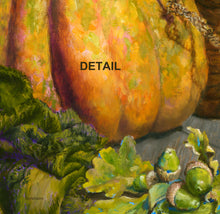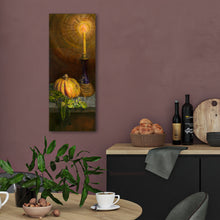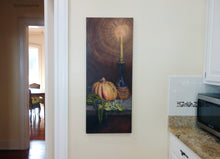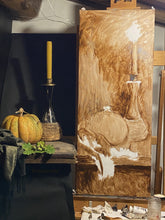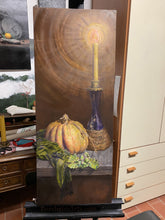
Pumpkin and Acorns painting
- 100 h X 40 cm (about 39.5 h x 16 inches)
- Oil on Gallery-wrapped Canvas (framing optional)
- Canvas wraps around the sides in case you do not want to use the frame
- © 2024-2025 Kelly Borsheim
- Available
The Painting Inspiration: Beauty and the Gift
Every year, my neighbor, age 92 at this writing, grows a bunch of pumpkins. In 2024, this one was my favorites. Not only beautifully shaped, but the curly vine left on the stem after she cut it appealed to me. This was one of several pumpkins she had sitting on her table after the harvest. [In case you never thought about it, as a pumpkin matures, it is better to place a piece of wood or a ceramic tile under the pumpkin, and rotate it once in a while if you like. It avoids rot from the humid soil. Not unlike avoiding a bed sore in the hospital, hahaha.]

I took the above photo on 5 October 2024, before I knew that I would receive this pumpkin as a gift. I just had to paint her!

Above, after some time in the days before for setting up the composition and lighting, I started on this painting on 10 October 2024. First, you see that I drew in the large shapes in charcoal. Corrections are much easier to make in this material.
I am using a method of drawing called "Sight-Size" and I stand about two meters / yards away to evaluate my marks. Walk up, make a mark, walk back to critique. Walk forward to either change the mark I did not like, or make a new one. A lot of back-and-forth walking, but a gal's gotta exercise!

Using a burnt umber color, I blocked in the overall shapes in the drawing, allowing the drips to occur. They will not stay, perhaps, but may be interesting as an underlying texture. Note that I left light in the areas of the candle flame, as well as were the main light source would hit the scarf and acorns.

Above, you may see that I painted the shapes of the acorns and its luscious leaves in a bright, but mid-toned blue. This is still the under-painting and I want to explore ways to add color to this eventually realism painting.

And here you may see that I did a similar concept with the scarf, painting purple as I develop the individual rounded folds of the fabric. You also see that I added a green on top of the blue leaves, leaving patches of the first color showing through in select places.

Now to start to develop the pumpkin. I used a medium-to-small size brush so that I could make small "blotchy" marks with slightly different colored paint, making sure to use the TONE that I needed to create a three-dimensional effect. I have two light sources in this composition, a new thing for me. And the flame on the candle will be totally invented. Thus, I must anticipate not only the light I see falling on the still life objects, but also remember that a weaker, more yellow light source will come from above and behind those objects. Color comes after tone if depth in the painting is my objective. I really enjoyed the rose pinks and oranges together!

Here I just wanted to you appreciate the small space in which I am working. My upstairs studio room has several easels set up with a variety of painting projects. But I always leave room for me to walk backwards and study my work from a distance.
Perhaps you may also note why I must work at night only on this painting. The daylight from the skylight window destroys the form of the still life objects and also does not light well enough the canvas. I do not work in what many artists would call an ideal studio, but I make what I have work for me.
You also note here my tripod because I try to make videos of my painting process. I do not have time to edit many of them, but I still manage to post some on my YouTube channel. I appreciate your interest and time in watching them, as well as any comments that you care to share.

Above: close-up the mark making looks VERY different from the optimal viewing distance of about two meters. I love that changing quality! This painting is in early stages.

October 19, 2024: Now I paint the metallic cup that holds the candle in this unusual candleholder that I bought a few months earlier in an antique market in Pescia (Tuscany, Italy).

Oh, goodness! I was so happy that I found this baby gecko before he succumbed to a fate of starvation. Once they and the little lizards all-around fall into a cup or even a large sink, they often cannot climb the slippery slopes of glass or smooth metal. That day, I had another assistant (often I have a dog at my feet, either my neighbor's or my landlord's). I am a lucky girl.

In this detail image above, I wanted to show you the mark-making, as well as the layered color choices that I put into the stars of this show (painting composition).

October 28, 2024: I have been traveling back and forth for days at a time in order to see my physical therapist, still healing from my spine surgery after an accident with THE wave in July 2023. Thus, at this point, I had enough of the front of the painting developed to know how to paint the SIDES of this gallery-wrapped canvas. Thus, I laid plastic on my bed (forever needing tables!) and set the canvas up on some wooden blocks I kept from when my landlord had new stairs made to replace the worn ones in my rented home.
This way, the paint had about four days to dry to the touch (oil paints take longer to actually CURE) and I would be ready to move forward again once home.

Just showing you the different texture of brushes I use for various objects in the painting. This rougher bristle one on the right was used to paint the basket weave covering the glass vase that makes up the antique candle holder.

Models drying up. Actually you may see that the acorn branch I found in the road in front of my house (from several oaks above the road) had already turned brown by the time I took the photo on 16 October. But here, you may see how with time, the dead leaves have really begun to curl up. When painting perishables, it is most important to draw soon the big shapes accurately so that when you draw the models that will die or move, you can capture all of their lovely ins and outs in RELATIONSHIP to the other objects in the composition. I no longer have the benefit of seeing those things now. Seize the moment!

Now to add the details. These are the tassels that dangle from the end of the green scarf. Pretty much three tones were used and I tried to make minimum strokes and in the direction of the twisting threads. Shadows will be added after this paint has dried a bit. It is part of the process to bounce around to work of different sections of the painting as the whole gets pulled into a finish together.

Here you see how I added the colors of the stem and shadow. The shadow will then be muted with soft edges and follow the form of the pumpkin. There is a lot of distance from the object casting the shadow and the shadow itself. Thus, the edges will be very soft after working the paint. And lighter than where the object is closer to the shadow. This reflects that light has plenty of space to lighten everything in that area.

December 22, 2024: You may notice that the multiple colors, especially the greens, have all faded away. It has been over two months since the pumpkin was cut from the vine.

It is important for each of us to keep our spines as vertical as possible when working on our feet, as I prefer to paint and sculpt. I also like to flip the canvas when working on a painting with the idea of an abstraction of shapes. (It is said that you can tell a good composition, an arrangement of shapes, if it looks pleasing to the eye regardless of how the painting is hung.)
And there is a practical benefit to working upside down: you do not risk having paint drip down onto the lower parts of the painting. Thus, I moved my canvas upside down to a table easel. Then I could create easier the concentric circles showing the light from the flame of the beeswax candle.

On my mother's birthday (12-23), I decided that it was time to eat the model! The knife I found in the attic of my house when I moved in eight years before is called a mezzaluna, literally "half moon" in Italian. I like this tool when cutting the large fruits, such as pumpkin and watermelon... any melon. And if I have a difficult time breaking into the skin, I just use the corner top edge of the blade to score the skin and can then rest the middle of the blade into the cut and make the move.
I love to eat the pumpkin meat, but also the seeds. How about you?

Here is a shot of my bedroom studio. I hate to be cold and I see no reason to heat the entire house just for me. Thus, I bought and had installed a pellet stove for my upper floor, but I close the burgundy door to the studio to keep my bedroom warmer. I currently have those two easels in there because as I finish the small details on a painting that is nearing completion, I often reward myself by spending part of the day working on something new and different. It keeps my brain hopping and interested.
This still life painting sat around during the holidays, curing. It was re-stretched (tighter) while painting the concentric circles. Final touches were done and the original painting was set aside to completely dry in March 2025. Often, I prefer to live with my art before I know if it is finished before I present my new baby to the world.
If interested in adding this still life painting to your art collection, please:







